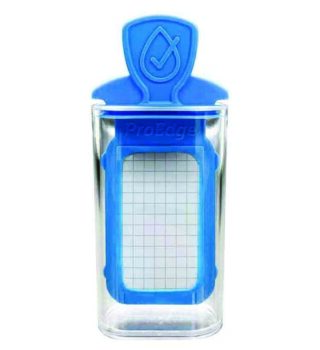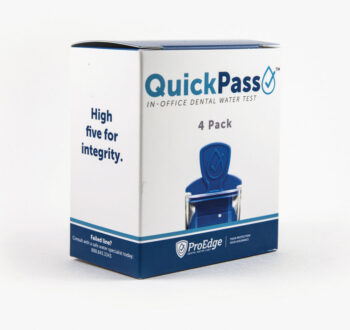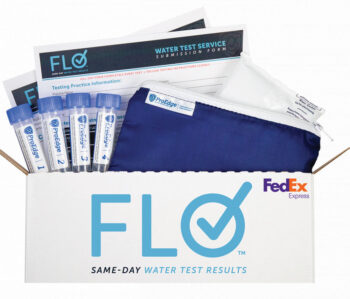No one likes being told what to do.
But when it comes to infection control in the dental space understanding the why and the how goes a long way in compliance. And the easier the how, the more likely the task will get done.

ProEdge offers a variety of easy-to-use waterline testing products like the QuickPass.
The Why of Water
Why are there regulations and guidelines around testing your dental unit waterlines? In the U.S. alone, there are three documented incidents where contaminated dental unit waterlines have seriously harmed patients.1 Go outside the U.S., and people have died from contaminated waterlines. New science also shows us that the aerosols we breathe in our operatories come directly from our procedural water.2 So, the health of our patients and our team is directly connected to what’s in your waterlines.
Washington state recently joined 32 other state dental boards requiring offices to test (and show) their dental unit water contains 500 CFU/mL or less of heterotrophic bacteria, meeting the EPA’s standard for safe drinking water. Even if you are using a product daily and shocking your lines regularly, the only way to know (and prove) if your water is safe is to test.
Effective December 1, 2021, WAC-246-817-660 went into effect in Washington. This regulation puts into place clear guidance for testing your dental unit waterlines (DUWLs).

ProEdge’s QuickPass® utilizes advanced scientific formulas to provide you with easy-to-read and more reliable results.
What It Means For You
- For all non-surgical procedures, a licensed dentist must use water that meets the EPA standard of 500 CFU/mL or less. We know patients and staff are at risk from contaminated DUWLs. Keeping the CFUs below 500 is a good threshold for mitigating risk.
- A licensed dentist will follow the dental equipment manufacturer’s instructions for testing DUWLs. If there are none available, test quarterly. Test 5-10 days after any repair or changes to the system and again 21-28 days later. Testing is the only way to know if your practice’s waterline maintenance program is working. When there are changes/repairs to units, it’s an opportunity for the introduction of biofilm. Testing twice at a spread-out interval ensures new growth hasn’t occurred.
- DUWLs for each operatory or unit can be tested individually or pooled as one sample. If using a pooled sample, you must take an equal amount from all the lines, up to 10 lines per test. Document the number of lines included in the sample. Pooled sampling has been shown to be effective if done correctly. Be sure to get as close to equal amounts as you can. If an operatory fails, you’ll shock all the lines. If it passes, you know you are clear until it’s time to test again.
- In the event of a failure, immediate action will be taken to attain a passing test. While the law doesn’t specify, it’s time to shock the lines with a strong disinfectant. There are lots of products on the market. Check to see if your dental equipment has instructions. If the CFUs are very high, shocking it three times in a row might be necessary to get to all the layers of biofilm.
- A licensed dentist shall record the testing and maintenance with the dates, results, and name of who conducted the test or maintenance. Keep these logs for five years. Like anything in dentistry, if you don’t write it down, it didn’t happen. It also helps you keep track of when to test again. Put the re-test date in your appointment book right away.
Waterline testing protects your practice and your patients.

ProEdge’s R2A Waterline Testing Kit
The Hows of Testing
Step 1: Choose A Test
Much like how you test your autoclave weekly, there are in-office and mail-in tests. In-office tests are convenient, economical, and confidential. But they are imprecise. Mail-in tests offer third-party verification and precise results. My office does a mail-in test once a year and in-office testing the other three quarters.
Step 2: Determine How Many Lines In
Your Operatory Can Receive Water You are not required to test each line individually. When done correctly, pooled sampling has been shown to assess the water quality in a single operatory accurately. Meaning you can take equal amounts of water from each line in one operatory, not the whole office. Prior to taking your sample, figure out how many lines get water so you know how to portion out your sample. Or if you want to test individual lines, you know how many tests to have on hand. Be sure to count every line, even if it’s one you don’t use, actually, especially if you don’t use it. This is often called a dead leg, and because the water doesn’t move, the biofilm is likely growing in there.
Step 3: Take A Sample
Flush each line for 30 seconds as you would before treating a patient. Then collect equal amounts of water in the test vial without contaminating the testing materials. If it’s an in-office test, pop in the paddle and let it sit for one minute before dumping out the water and closing it back up again to see what grows. If it’s a mail-in test, pop the lid on and get it ready for mailing.
Step 4: Document
There are some specific rules on what to document. Be sure to include the date you tested, who did the testing, how many lines you pooled together, and what the results were. If it’s an in-office test, take pictures of the paddle for proof. If it’s mail-in, keep the results from the independent testing entity. Hang on to these for five years. If you passed, congrats. Check the dental equipment instructions for when to test again, and if it doesn’t say, test again in three months. If you failed, it’s time to shock. Having an established waterline protocol that includes testing, shocking, and treating will put you on the road to passing the test. And delivering safe care. Appoint a Waterline Warrior in your practice to take on this important responsibility
Studies show after about a year of regular water testing, offices pass 91% of the time.
If you passed, congrats. Check the dental equipment instructions for when to test again, and if it doesn’t say, test again in three months. If you failed, it’s time
to shock.
Having an established waterline protocol that includes testing, shocking, and treating will put you on the road to passing the test. And delivering safe care. Appoint a Waterline Warrior in your practice to take on this important responsibility.
Written by Amanda Hill, RSDH, RDH
Submitted by ProEdge.
Published in Catalyst – Q3 2023.
Category: Merchandise
Back to Articles